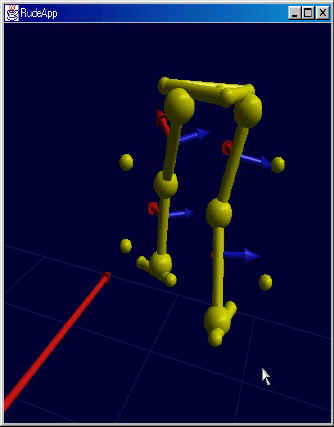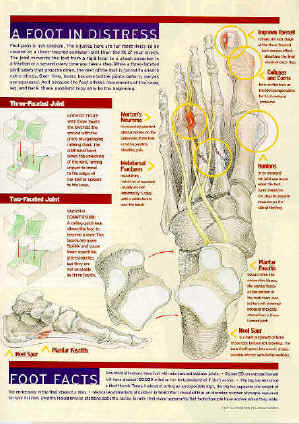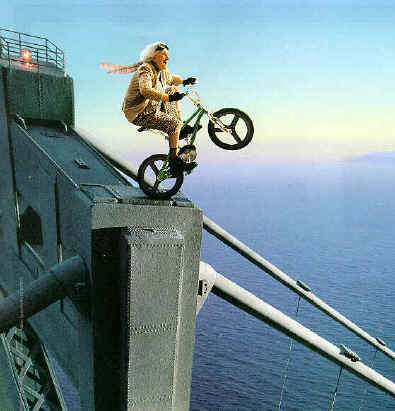Basic Assumptions of Gait Analysis


APASgait, Discover Magazine, November 1999
In order to perform a gait analysis, you must have some
basic measurements. For example, if you want to know the speed of a car, you must
have some velocity measurement device. In the car, it is the speedometer but how
accurate is this speedometer? Let's assume that it is 100 percent accurate. What
happens if your tires are worn and the radius of the wheel has been decreased by 5 cm or
the tire pressure is higher or lower than the manufacturer advises? How will these
tire variations effect the velocity? This can be calculated but most drivers ignore
this factor. Thus, the speedometer in the car is very good at estimating the car
velocity. This estimate is "almost" a direct measurement. With human
gait, measuring ground reaction forces on a force plate give a very good measurement of
forces at the contact point with the plate. But just as the car's speedometer is an
estimate of the car's velocity, the force platform can only be utilized with other factors
to estimate the internal forces in the ankle joint or the knee joint? These calculations
are, at best, merely estimates, and using them otherwise is relatively inaccurate.
If you are outside the car, how can it's speed be calculated?
Some indirect methods could be employed. For example, using a stop watch to measure the
time between two known points or across a known distance could produce velocity
estimates. Of course, the obvious errors of this estimate include the accuracy
of the distance measurement, the watch, and the person operating the watch. Just as
these car speed calculations have inherent errors of measurements, calculation of
ground reaction forces without a force plate and trying to determine joint forces have
measurement errors.

In his book, Dr. Christopher Vaughan
mentions a few error sources. Let's review them as Dr. Vaughan writes about
"Problems of Estimation":
Problems in estimation: in attempting to estimate the body segment parameters for an individual
subject, there are various approaches that can be followed. These include
• cadaver averages (Braune & Fischer, 1889; Dempster,
1955);
• reaction board (Bernstein, 1967);
• mathematical modeling (Hanavan, 1964; Hatze, 1980);
• scans using gamma rays, axial tomography, or magnetic resonance imaging (Brooks
& Jacobs, 1975; Erdmann, 1989; Zatsiorsky & Seluyanov,1985); and
• kinematic measurements (Ackland, Blanksby, & Bloomfield, 1988; Dainis,1980;
Vaughan, Andrews, & Hay, 1982).
Each of these has severe limitations. The cadaver averages are not sufficiently
specific for individual subjects and very often only total body mass is used as a
predictive variable. The reaction board technique is a long and tedious procedure which
cannot estimate segment masses and centers of gravity independently. Mathematical modeling
suffers from the disadvantage that too many variables (242 in the case of Hatze’s
model) need to be measured, thus requiring an inordinate amount of time and patience.
Scanning techniques,though potentially very accurate and detailed, must be seriously
questioned as a routine method because of the radiation exposure and high costs. Although
they have some appeal, kinematic measurements either have not yielded results to a
satisfactory degree of accuracy or require too much time (Jensen,1986).
Dr. Herbert Hatze, from the University of Vienna,
is probably one of the most knowledgeable biomechanist today. He developed a model to
estimate body parameters and concluded that 242 variables are needed to arrive at any
level of validity. Although this is impractical, his point is that there is some
level of inaccuracy with any method. In his mind, there is no way to calculate Gait
parameters the way they are proposed today. With the introduction of MRI data into
the APASgait model, the model estimation power will increase exponentially. The late
Dr. Herman Woltring believed that helical angle calculations of joint centers would be an
improvement over the the currently utilized Euler/Cardan angles. Some of the mathematics
involved in calculating helical angles can be found at:
http://www.cs.bsu.edu/~ykwon/kwon3d/theory/helical/helical.htm
Consider the simple example of determining the velocity
of a car discussed previously. Utilizing the same variables to model human
movement would result in more than 200 instruments to determine the car's speed! Of
course, it might eliminate any future speeding traffic violation, but it is clearly
impractical.
So, it should be understood that Gait Analysis is only an
estimate utilizing simple mathematical calculations of locations of joint centers and
rotation of rigid segments about the joint. Inputting direct measurement from force
platforms and electromyography systems into "estimates" does not improve the
results!!! In fact, in attempting to calculate kinetic parameters from these equipment
only increase the level of errors in estimating forces and moments around the various
body's joints.
Ariel Dynamics Inc. utilizes various techniques published in
the literature to calculate gait parameters. Since all these techniques rely on the
location of coordinates of markers, the only variations between the various technique are
the markers themselves and their locations. Ariel Dynamics, Inc.operates with the
goal to provide as many tools and techniques as possible to allow you, the investigator,
to select your own technique and marker sets.
Ariel Dynamics operates with the thought that Gait Analysis is
still in its infancy and that each researcher, doctor, or practitioner has his or her own
personal opinion. Therefore, having the video in addition to the calculations,
it is possible to make an intelligent estimation of the accuracy of the calculations. By
superimposing the "stick figures" results over the video, you can observe the
derivations from the actual movement. In addition, the video allows running the
gait analysis utilizing all the mathematical methods that exist and comparing the
results. Collecting coordinates from markers that move in space without the raw video
data is like estimating the speed of a car in the dark without seeing it.
What is the solution? As recently as the November Issue
of Discover Magazine, (November, 1999), a leading article in the magazine described how
the APAS was used to analyze gait. At the University of Copenhagen, the APAS gait analysis
system has been used for years by Dr. Erik Simonsen. One of the most extensive APAS
gait analysis is being used and perfected by Dr. Sun Chung M.D and Ph.D. of the
Seoul National University of Medicine. Dr. Chung's system utilizes modified the
markers sets to optimize gait parameters and take a full advantage of the video source
data.
The next page will describe the general principles of the APASgait.
|